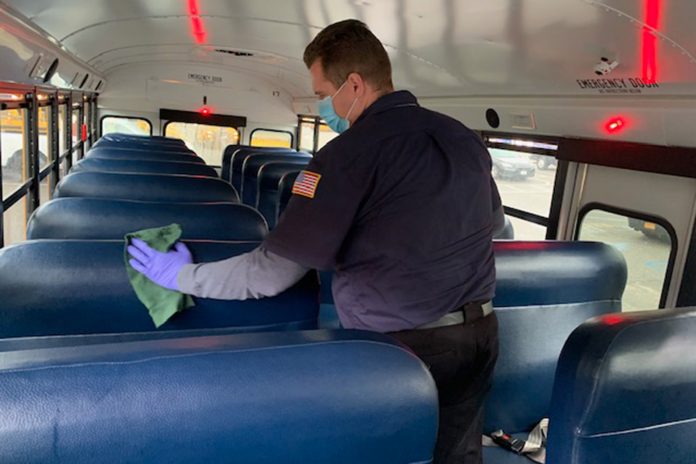In addressing technologies typically used on school buses transporting children, the U.S. Environmental Protection Agency (EPA) is conducting research to evaluate different types of cleaning and disinfection methods and technologies for reducing the risk of coming in contact with viruses on surfaces and in the air.
This includes evaluating disinfectant product application with electrostatic sprayers, the use of antimicrobial coatings that are intended to have long-lasting effects, and air treatment technologies that aim to reduce the airborne concentration of viruses, noted Katherine Ratliff, Ph.D., a physical scientist with the EPA’s Office of Research and Development, Center for Environmental Solutions and Emergency Response, Homeland Security and Materials Management Division.
“For example, EPA is conducting research to evaluate how effective different types of alternative disinfection devices, such as those that produce UV-C radiation or ozone to be used in unoccupied spaces only, are against the SARS-CoV-2 virus on surfaces common to school buses, including plastic and stainless steel,” she explained.
The overarching goal of the research is to better understand how these technologies and methods can be applied to help states, tribes, local, and territorial governments make decisions that reduce the risk of exposure to SARS-CoV-2 and mitigate the spread of COVID-19, Ratliff added.
Until the research can be translated to real-world applications, Ratliff pointed out that one of the best ways to reduce the risk of spreading COVID-19 is to wear a well-fitting mask in enclosed public settings, including on school buses.
“In fact, the U.S. Centers for Disease Control [and Prevention] requires the wearing of a mask over your nose and mouth on buses,” said Ratliff.
Opening windows on buses to increase the amount of fresh air circulation and – when possible – upgrading filters in HVAC systems are also proven strategies for reducing the risk of airborne transmission of diseases, she added.
“EPA is conducting research to evaluate air treatment technologies that aim to reduce airborne concentrations of viruses and other contaminants,” she shared. “These technologies are of particular interest for use in enclosed spaces, where upgrading filters or introducing additional fresh air is not feasible, but they do not replace public health guidelines such as mask-wearing and social distancing.
“Many of these technologies are still considered to be emerging and how effective they are as well as how safe they are, particularly for sensitive populations such as children, is not fully understood,” Ratliff concluded.
Related: Pennsylvania School Bus Aide Allegedly Sprays Students with Cleaning Solution
Related: What Are the Long Term-Effects of Disinfecting School Buses?
Related: School Bus Disinfectants, Sanitizers, and Antimicrobials … Oh My!!
Related: Students Need School Bus Air As Clean As in Their Classroom














